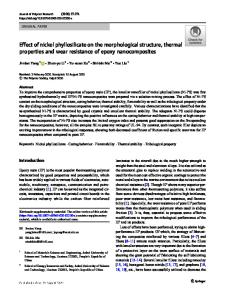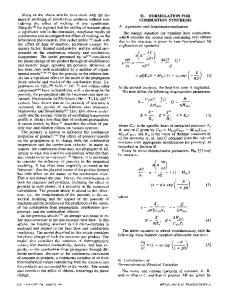Effect of Active Diluents on Properties of Epoxy Compounds and Coatings Based on Them
- PDF / 320,126 Bytes
- 9 Pages / 612 x 792 pts (letter) Page_size
- 12 Downloads / 323 Views
OMOLECULAR COMPOUNDS AND POLYMERIC MATERIALS
Effect of Active Diluents on Properties of Epoxy Compounds and Coatings Based on Them V. G. Kurbatova,b,*, T. A. Pugachevaa,b, G. V. Malkova,b, M. S. Krasikovab, I. V. Golikova, and A. A. Il’ina b
a Yaroslavl State Technical University, Yaroslavl, 150023 Russia Institute of Problems of Chemical Physics, Russian Academy of Sciences, Chernogolovka, Moscow oblast, 142432 Russia *e-mail: [email protected]
Received May 6, 2020; revised May 20, 2020; accepted July 29, 2020
Abstract—The structure of an active diluent influences the rheological properties of epoxy compounds. The use of a linear alkyl glycidyl ether allows preparation of compounds with the lowest dynamic viscosity. As the active diluent content is increased from 0 to 20%, the period in which the network polymer is formed in the course of curing of epoxy compounds increases from 5 to 30 min because of a decrease in the rate of consumption of epoxy groups in the compound with an increase in the active diluent content. The elastic-strain and thermal properties of epoxy polymer films were studied. When using a linear alkyl glycidyl ether as an active diluent, the ultimate strength and glass transition temperature as functions of the diluent content pass through a minimum. Introduction of monofunctional active diluents into the compound leads to a decrease in the elastic modulus. An increase in their content in the compound from 5 to 20% does not affect the elastic modulus. Keywords: epoxy oligomers, active diluents, curing, elastic-strain properties, glass transition temperature DOI: 10.1134/S1070427220090050
Much attention is paid today to the development of paint-and-varnish materials with low content of volatile organic substances. This problem can be solved by using aqueous dispersions of polymers or preparing organicsoluble systems containing no classical organic solvents that are evaporated into air in the course of curing. The viscosity of such systems can be controlled using socalled active diluents, which become incorporated in the formed network structure upon curing. Widely used systems of this type include unsaturated polyesters (active diluents in such systems are unsaturated monomers, e.g., styrene, methyl methacrylate, etc.) [1–3], acrylic oligomers (with polyols derived from ε-caprolactone as active diluents) [4–6], and epoxy oligomers (possible active diluents in this case are, e.g., aliphatic epoxy oligomers or monofunctional compounds containing epoxy groups) [7–9]. However, in the above papers, an active diluent is considered as an alternative to commonly used solvents only from the viewpoint of controlling the viscosity of the material. The effect of the structure and functionality of the active diluent on the properties of the
coatings formed has not been evaluated, which does not allow correct evaluation of changes in the properties of coatings formed from the given compound. On the other hand, incorporation of an active diluent into a polymer network can influence its structure and hence its op
Data Loading...











